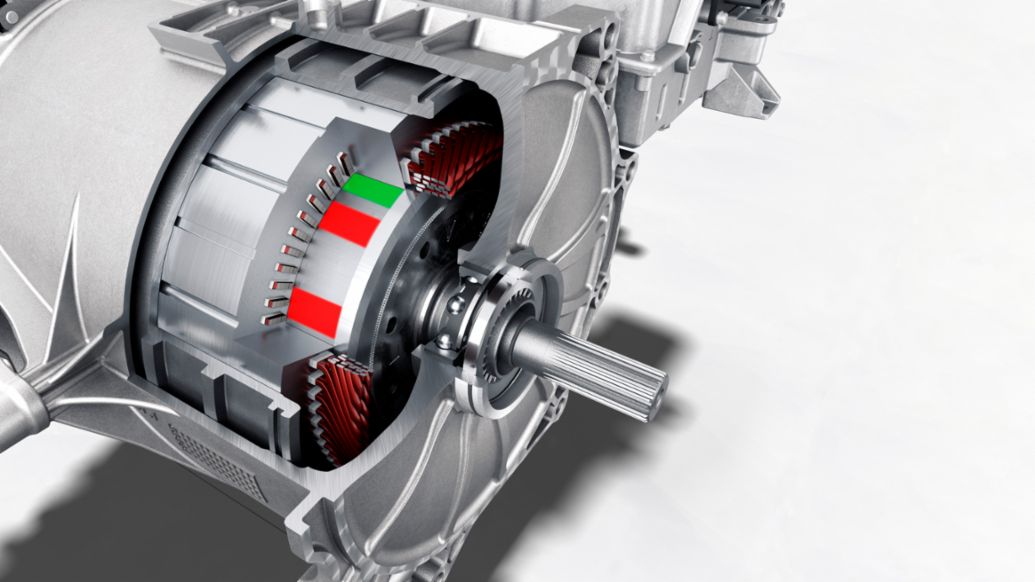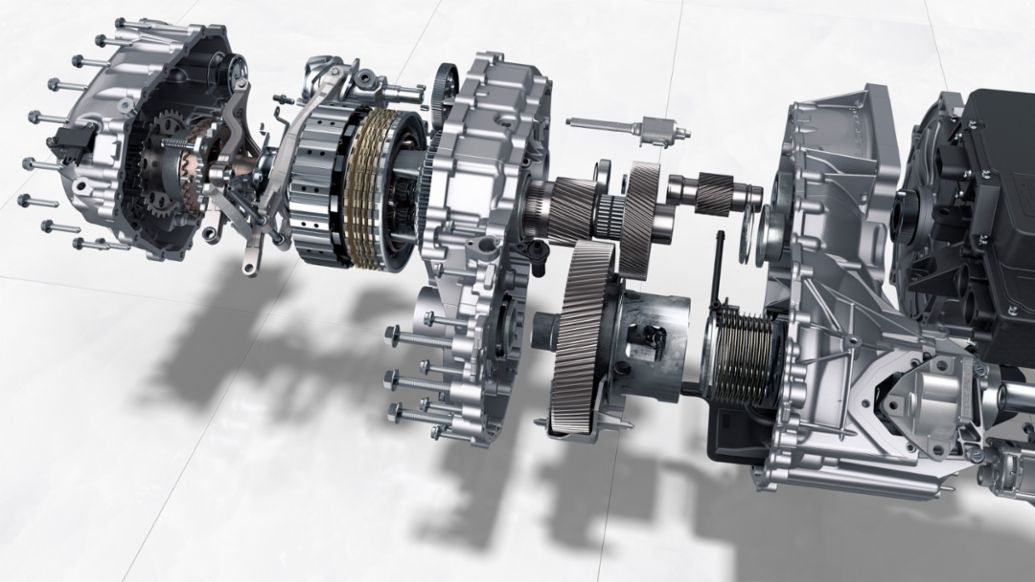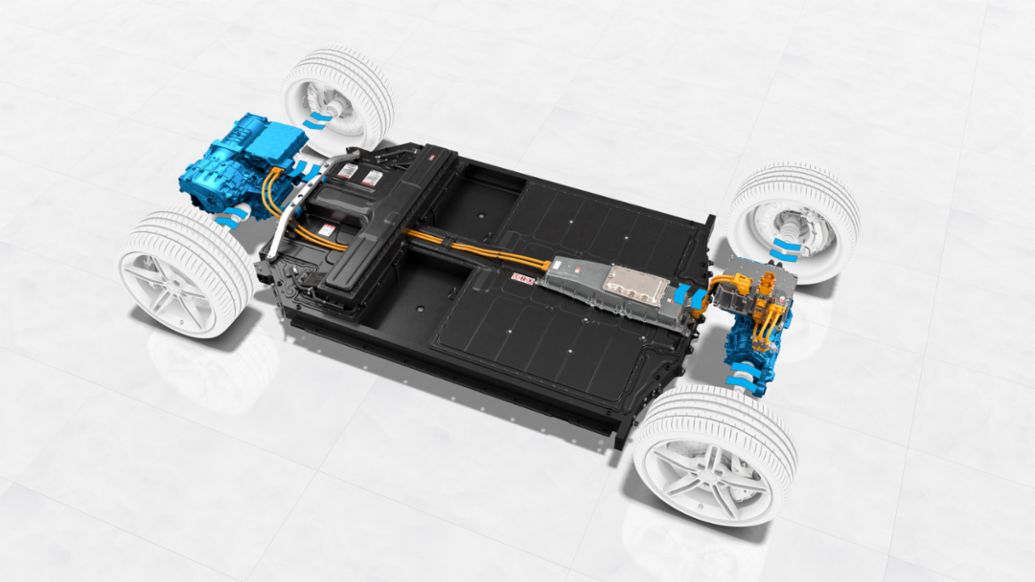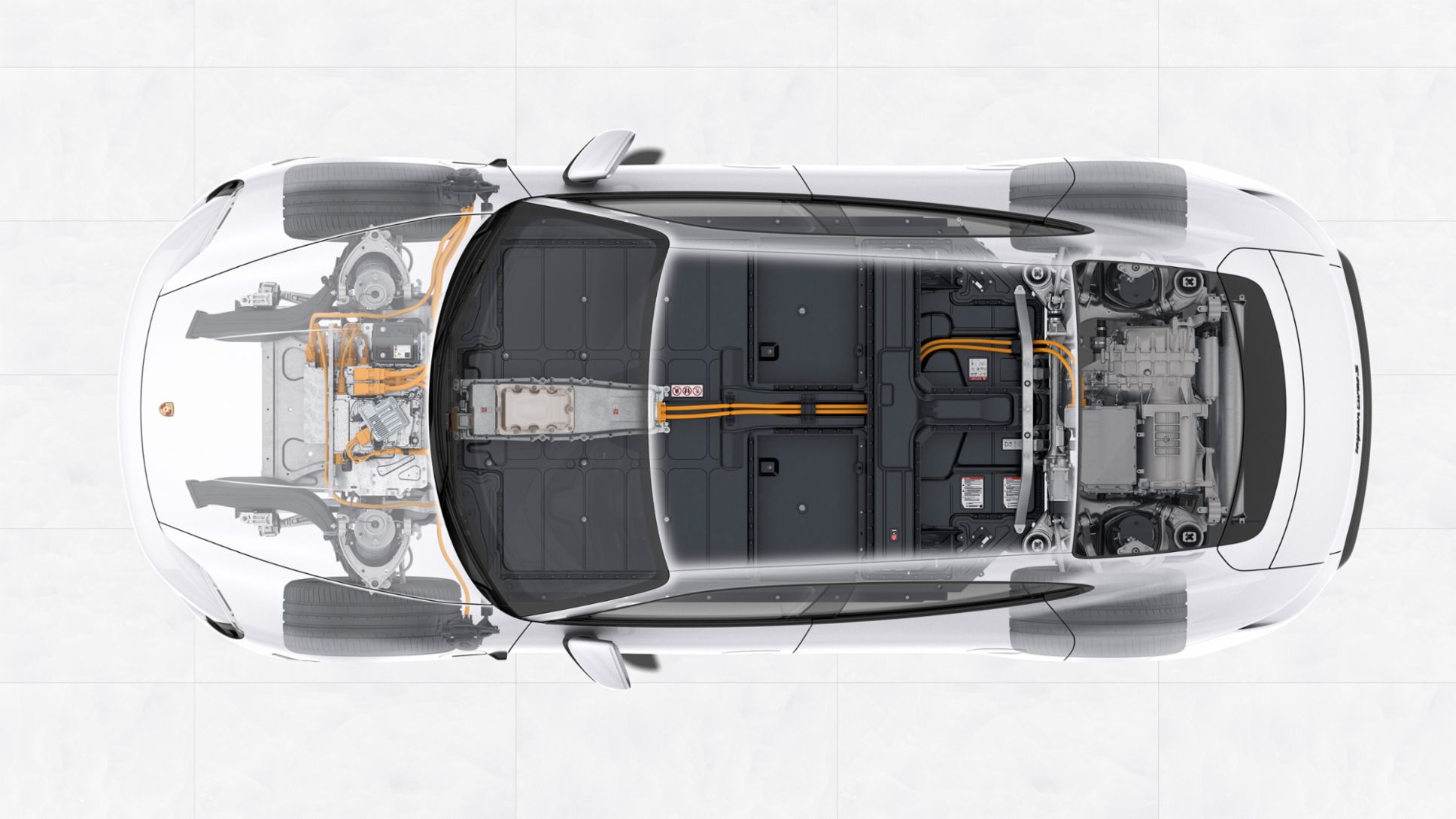This makes it unique in its segment. The top Turbo S version of the Taycan can generate up to 560 kW (761 PS) overboost power in combination with Launch Control, and the Taycan Turbo up to 500 kW (680 PS) . The Taycan Turbo S accelerates from 0-100 km/h in 2.8 seconds, and the Taycan Turbo in 3.2 seconds. The top model reaches the 200 km/h mark in 9.8 seconds, while the Turbo takes 10.6 seconds. The range of the Turbo S is up to 412 kilometres, and up to 450 kilometres for the Turbo (according to WLTP). The top speed of both all-wheel-drive models is 260 km/h.
The Taycan is started by engaging the driving mode while the brake pedal is depressed. Alternatively, this can also be done by pressing a button. As with the ignition lock on conventional Porsche models, the power button is located on the left behind the steering wheel.
The electric motors: synchronous motors with hairpin winding
The Taycan Turbo S and Taycan Turbo have two exceptionally efficient electric motors, one on the front axle and one on the rear axle, thus making the cars all-wheel drive. Both the range and the continuous power of the drive benefit from the high efficiency of the permanently excited synchronous motors. The electric machine, transmission and pulse-controlled inverter are combined into a compact drive module. The rear axle module is installed parallel to the axle. The pulse-controlled inverter is mounted on this in a “balcony solution” to increase the luggage compartment volume. Thanks to its coaxial design, the front axle module is integrated into the front of the vehicle in a very small space.
Permanently excited synchronous motors have a rotor with high-quality permanent magnets that generate a natural magnetic field. The rotor thus moves in sync with the magnetic rotating field of the stator, which is why it is known as a permanently excited synchronous motor. A pulse-controlled inverter specifies the frequency of the rotating field in the stator, therefore determining rotor speed. On account of their structure, functionality and their excellent thermal behaviour, the Permanently excited synchronous motors are able to deliver the high performance typical for Porsche.

A special feature of the Taycan’s electric motors is the hairpin winding. in which the solenoid coils of the stator consist of rectangular rather than round wires. The wires are bent and their shape — before they are inserted into the stator's laminated core — is reminiscent of that of hairpins, hence the name “hairpin”. The open ends are welded together using a laser beam. The manufacturing process of hairpin technology is complex, but it allows the wires to be packed more densely and thus increase the amount of copper in the stator. While conventional winding processes have a copper filling factor of around 45 percent, it is just under 70 percent in this case. This increases power output and torque for the same volume. Another important advantage for a high-performance car like the Taycan is that a hairpin stator can be cooled considerably more efficiently.
The liquid-cooled synchronous motor on the front axle has an active length of 160 millimetres and an active diameter of 190 millimetres. Its counterpart on the rear axle is 210 millimetres long and has a diameter of 245 millimetres. All in all, the modules have the highest power density (kW per litre of package space) of all the electric powertrains on the market today.
Pulse-controlled inverters control the motors
The pulse‑controlled inverter is the most important component for controlling the electric motors. In the Taycan Turbo and Turbo S, a pulse-controlled inverter is mounted on each drive module on the front and rear axles. The pulse-controlled inverters convert the direct current supplied by the Performance Battery Plus into the alternating current required to drive the electric motors. The reverse happens during braking: Here they convert the alternating current obtained during recuperation into direct current for charging the battery. In the Taycan Turbo S, a pulse-controlled inverter with a maximum current of 600 amps is used on the front axle, which can generate even more power and torque than the 300-amp, pulse-controlled inverter of the Taycan Turbo. Both pulse-controlled inverters operate with a remarkably high efficiency of almost 98 per cent.
Power transmission: two-speed transmission unique to Porsche
On the front axle, the power of the electric motor is transmitted to the front wheels via a coaxial, compact one-speed planetary gear with an overall ratio of approx. 8:1 to an integrated spur-gear lightweight differential.
The two-speed transmission installed on the rear axle in the Taycan is an innovation developed by Porsche. First gear gives the Taycan even more acceleration from a standing start, while the long second gear ensures high efficiency and power reserves even at very high speeds.

The two-speed transmission is based on three shafts. In addition to the two spur gear stages, which technically represent the ratio of the second gear, a shiftable planetary gear set is also used, which enables a corresponding reduction for the very short first gear. Roughly 15 revolutions of the motor represent one revolution of the wheel. This results in a very high wheel torque of almost 12,000 Nm, which allows breathtaking acceleration from a standing start.
First gear is mainly used in Sport or Sport Plus driving modes. Launch Control is also available in these modes. The transmission remains in first gear for a relatively long time, then shifts into second gear with a shift overboost.
Second gear has a ratio of around 8:1 like the transmission on the front axle. Eight revolutions of the electric motor thus represent one revolution of the wheel. This enables a top speed of 260 km/h typical of a sports car and acceleration reserves at high speeds. The rear axle has a controllable differential lock.
Recuperation: recovering high levels of energy
In internal combustion engine vehicles, the kinetic energy present at the brakes is converted into heat during deceleration. With electric vehicles, it is possible to recover a large portion of this kinetic energy, use the electric motors as generators during deceleration, and feed the battery with the power generated.

In the Taycan, Porsche takes its own approach in a number of ways within these parameters:
-
The maximum potential recuperation capacity of up to 265 kW is significantly greater than that of most competitors, decelerations of up to 3.8 m/s2 are recuperated.
-
When the accelerator pedal is released, the Taycan is designed to always roll or coast as far as possible; the available kinetic energy is reserved for dealing with the driving route.
-
Recuperation takes place only when the brake pedal is pressed, but then, as mentioned above, with a very high level of energy recovery.
With the strategy of controlling recuperation mainly via the brake pedal, the customer experiences reproducible and predictable deceleration behaviour which is independent of battery charge and temperature. Testing has shown that, Thanks to the Taycan’s high recuperation output of up to 265 kW, approximately 90 percent of braking operations in everyday use are performed by the electric motors alone, without activating the wheel brakes. For this reason and for the first time ever, Porsche is prescribing a time-dependent replacement interval for the brake pads: they must be replaced every six years.
The driving modes: unrestricted choice of long range or maximum sportiness
The profile of the driving modes in the new Taycan essentially follows the same philosophy as in the other Porsche model series. This is supplemented by special settings to make optimum use of the possibilities offered by the purely electric drive. Four driving modes are available: Range, Normal, Sport and Sport Plus. In addition, individual systems can be configured as required in the "Individual" mode. A prerequisite for the Sport Plus and Individual modes is the Sport Chrono package (standard in the Turbo S), and which features the mode switch integrated in the steering wheel.
Range
The Taycan performs particularly efficiently in Range mode. The top speed is limited to between 90 and 140 km/h (adjustable) but can always be overridden by depressing the accelerator pedal. Driving in this mode means driving with the most efficient all-wheel distribution possible. In extreme cases, the Taycan will even drive exclusively on the front axle. Cooling air flaps, chassis height (-20 millimetres) and rear spoiler are set to the minimum drag. Air conditioning, hydraulic pumps, air suspension and headlights also operate in their most efficient configurations.
Normal
In the basic setting, the Taycan delivers its power output on a linear basis. All four wheels are driven in efficiency mode. The cooling air flaps are only opened when necessary, the rear spoiler is adjusted depending on the speed and the chassis is lowered as required. Climate control and adaptive cruise control operate without restriction, the air suspension offers full comfort.
Sport
The highest performance of the powertrain is available in the Sport and Sport Plus modes. Driver requests are implemented dynamically. The all-wheel drive changes to rear-biased distribution and is dynamically controlled. The battery's cooling and heating strategy is designed for performance. The cooling air flaps are thermally controlled depending on the required cooling capacity, while the rear spoiler control is speed-dependent. The climate control regulates without restriction, the adaptive cruise control is more dynamic (including more powerful acceleration). And the cornering lights’ functionality is also more dynamic. The air suspension lowers the Taycan by up to 22 millimetres depending on speed, while the suspension, including rear axle steering, is adjusted to a sporty setup.
Sport Plus
“Sport Plus” puts an even more dynamic spin on the driver’s style. As a result, the battery’s cooling and heating strategy has been designed for maximum performance. At the same time, the cooling air flaps are opened, the rear spoiler is extended for minimal lift early on, The chassis setup, including rear axle steering and PDCC, is optimised for maximum race track performance, and the chassis permanently remains in the lowest position (-22 millimetres).
All the systems available on the powertrain are controlled by the Porsche powertrain controller. This is where all the information is collected and the high-speed actuators are controlled. The all-wheel drive and traction control systems operate five times faster than conventional systems. If one wheel has more slip, for example, the electric motors regulate it at lightning speed - a particularly impressive experience on snow and ice.
Driving performances: always convincing
The electric powertrain is capable of highly responsive acceleration. However, Porsche is also committed to ensuring that this can also be done multiple times in succession. The new Taycan Turbo S is therefore able to reproduce its impressive acceleration time of 2.8 seconds for the sprint from 0-100 km/h 10 times in succession without any problems. This acceleration performance is also impressive at high speeds. The new Taycan also proves its performance capability multiple times in succession without any drop in performance, for example when accelerating out of bends onto a long straight.
Launch Control: And full speed ahead!
Launch Control enables maximum acceleration from a standstill and is a standard feature in the Taycan. It uses an overboost function where the electric motors are provided with more power. In the Taycan Turbo S, a power output of 560 kW is provided at this point.
Additional content
Sports cars, redesigned with sustainability in mind. The first all-electric sports car, the Taycan, marks the beginning of a new era for Porsche as the company systematically expands its product range in the field of e-mobility. An overview.

